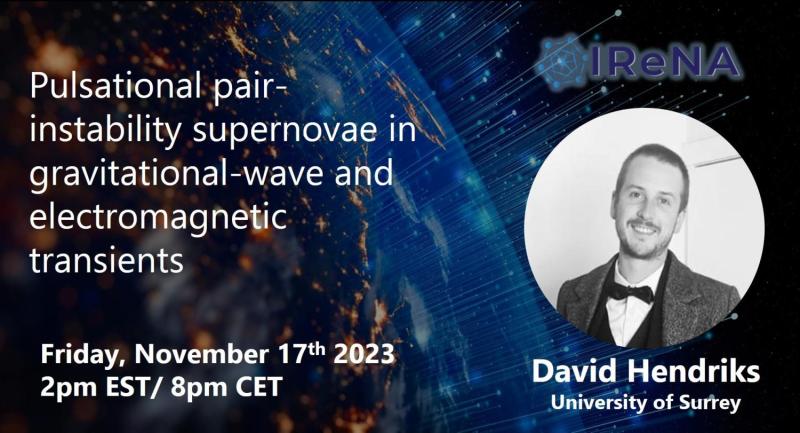Data
You will be redirected to cenamweb.org in 15 second(s). The JINA-CEE website is not updated anymore. The archived website can still be reached through the CeNAM website.
POSTPONED: Pulsational pair-instability supernovae in gravitational-wave and electromagnetic transients featuring David Hendriks (University of Surrey)

*THIS SEMINAR HAS BEEN POSTPONED TO FRIDAY, DECEMBER 8th AT 2PM EASTERN TIME*
Hosted by: Rob Yates (University of Hertfordshire)
Current observations of binary black-hole (BBH) merger events show support for a feature in the primary BH-mass distribution at ∼ 35 M , previously interpreted as a signature of pulsational pair-instability (PPISN) supernovae. Such supernovae are expected to map a wide range of pre-supernova carbon-oxygen (CO) core masses to a narrow range of BH masses, producing a peak in the BH mass distribution. However, recent numerical simulations place the mass location of this peak above 50 M. Motivated by uncertainties in the progenitor’s evolution and explosion mechanism, we explore how modifying the distribution of BH masses resulting from PPISN affects the populations of gravitational-wave (GW) and electromagnetic (EM) transients. To this end, we simulate populations of isolated BBH systems and combine them with cosmic star-formation rates. Our results are the first cosmological BBH-merger predictions made using the binary_c rapid population synthesis framework. We find that our fiducial model does not match the observed GW peak. We can only explain the 35 M peak with PPISNe by shifting the expected CO core-mass range for PPISN downwards by ∼ 15 Msun. Apart from being in tension with state-of-the art stellar models, we also find that this is likely in tension with the observed rate of hydrogen-less super-luminous supernovae. Conversely, shifting the mass range upward, based on recent stellar models, leads to a predicted third peak in the BH mass function at ∼ 64 Msun. The shape and height of this peak is sensitive details of the PPISN mechanism, nuclear physics and the maximum stellar mass, and, as such, uncovering a peak feature here may inform us about these properties. This upward shift is supported by recent detailed stellar evolution models and softens the tension with the observed transient rates. Upcoming observation runs will increase detections in the high-mass range and may indeed uncover this newly proposed peak. As such, they will improve our understanding of the details of the PPISN mechanism.
